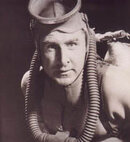You are using an out of date browser. It may not display this or other websites correctly.
You should upgrade or use an alternative browser.
You should upgrade or use an alternative browser.
Wearing a mask on forehead a distress signal, now that seems ridiculous!
- Thread starter Z Gear
- Start date
Please register or login
Welcome to ScubaBoard, the world's largest scuba diving community. Registration is not required to read the forums, but we encourage you to join. Joining has its benefits and enables you to participate in the discussions.
Benefits of registering include
- Ability to post and comment on topics and discussions.
- A Free photo gallery to share your dive photos with the world.
- You can make this box go away
Kharon
Contributor
My OW instructor added (to the primary nonsensical reason) that if you put your mask on your forehead it will fog. Like that won't happen if it's on the back of your head?
After thinking about it a bit more, the problem with MOF as a sign of distress is that the rate of false positives is waaaay too high.
Say 100% of people in distress at the surface have MOF, and 50% of people not in distress have MOF. If the rate of divers in distress is 1 in 1000, then out of 1000 people, you're going to get 499.5 not in distress and without MOF, 499.5 not in distress and with MOF, and one in distress and with MOF.
In other words, MOF will be wrong 498.5 times out of 499.5, which is about 99.8% of the time?
Those numbers are made up, but I don't think the result changes much as long as you use realistic numbers such that (1) a lot of divers put MOF even when they're fine, and (2) the base rate of divers in distress is low.
Say 100% of people in distress at the surface have MOF, and 50% of people not in distress have MOF. If the rate of divers in distress is 1 in 1000, then out of 1000 people, you're going to get 499.5 not in distress and without MOF, 499.5 not in distress and with MOF, and one in distress and with MOF.
In other words, MOF will be wrong 498.5 times out of 499.5, which is about 99.8% of the time?
Those numbers are made up, but I don't think the result changes much as long as you use realistic numbers such that (1) a lot of divers put MOF even when they're fine, and (2) the base rate of divers in distress is low.
After thinking about it a bit more, the problem with MOF as a sign of distress is that the rate of false positives is waaaay too high.
Say 100% of people in distress at the surface have MOF, and 50% of people not in distress have MOF. If the rate of divers in distress is 1 in 1000, then out of 1000 people, you're going to get 499.5 not in distress and without MOF, 499.5 not in distress and with MOF, and one in distress and with MOF.
In other words, MOF will be wrong 498.5 times out of 499.5, which is about 99.8% of the time?
Those numbers are made up, but I don't think the result changes much as long as you use realistic numbers such that (1) a lot of divers put MOF even when they're fine, and (2) the base rate of divers in distress is low.
Good correlation. This is actually why I think it is completely misleading and confusing, and not an effective means of communicating a distressed situation.
rwkosh
Contributor
My OW instructor added (to the primary nonsensical reason) that if you put your mask on your forehead it will fog. Like that won't happen if it's on the back of your head?
This is one of the reasons that I wear it on my forehead. If I leave the mask on while I'm floating around waiting for the other divers to finish suiting up and jumping off the boat, my mask will fog up. The simple solution is to put it up on my forehead. It's easier to breath that way too. If it was good enough for Mike Nelson, it's good enough for me.
gfaith
Contributor
Yeah... and he's dead! So there's that...
---------- Post added February 19th, 2015 at 08:25 PM ----------
After thinking about it a bit more, the problem with MOF as a sign of distress is that the rate of false positives is waaaay too high.
But the sensitivity/specificity of any diagnostic needs to be evaluated within the context of the effort/cost involved in following up on the information it provides. Essentially "what is the cost and negative risk associated with a false-negative?"
Here's the whole process:
1.) See diver with mask on forehead.
2.) Look for other signs of distress.
3.) Proceed accordingly
In the case of MOF... appropriate follow-up is simply one more second of evaluation. Which makes it a fairly "resource-efficient" evaluation. Plus, the potential upside to catching the one-in-100 "true-positive" is well worth the 1 second invested in each of the 99 "false positive" cases. It's not like anyone is suggesting that a squadron of Coast Guard Herc-130s be dispatched.
Continuing the scientific approach, is there any actual evidence that a mask placed on forehead is a sign of distress?RJP:But the sensitivity/specificity of any diagnostic needs to be evaluated within the context of the effort/cost involved in following up on the information it provides. Essentially "what is the cost and negative risk associated with a false-negative?"
Here's the whole process:
1.) See diver with mask on forehead.
2.) Look for other signs of distress.
3.) Proceed accordingly
In the case of MOF... appropriate follow-up is simply one more second of evaluation. Which makes it a fairly "resource-efficient" evaluation. Plus, the potential upside to catching the one-in-100 "true-positive" is well worth the 1 second invested in each of the 99 "false positive" cases. It's not like anyone is suggesting that a squadron of Coast Guard Herc-130s be dispatched.
Good correlation. This is actually why I think it is completely misleading and confusing, and not an effective means of communicating a distressed situation.
It is NOT MEANT TO COMMUNICATE A DISTRESS SITUATION any more than a cough is "an effective means to communicate a pneumonia diagnosis."
Please tell me that you understand that MOF is not intended to be something a diver is expected to proactively do in order to alert others to the fact that they are in distress. (ie it is not "a signal" but "a sign")
---------- Post added February 19th, 2015 at 08:31 PM ----------
continuing the scientific approach, is there any actual evidence that a mask placed on forehead is a sign of distress?
Empirical observation.
flots am
Contributor
- Messages
- 3,226
- Reaction score
- 1,861
- # of dives
- I just don't log dives
I know that most are taught to wear the mask under the chin when wanting to temporarily remove the mask. But sometimes I tend to place mine over my fore head. I don't understand how this should be regarded as some sort of distress signal. It seems ridiculous.
It's a sign, not an intentional signal.
Equipment rejection is a common sign of impaired thinking or panic. You'll often see mountain climbers or hikers with hypothermia losing important items like hats and gloves.
flots.
Similar threads
- Replies
- 110
- Views
- 9,113
- Replies
- 4
- Views
- 744
- Replies
- 2
- Views
- 528
- Replies
- 11
- Views
- 936




